How to reduce your risk of Parkinson’s disease
16 January 2023
Opinion: Parkinson’s doesn't only affect older people, but there are lifestyle changes you can make to dramatically reduce your chances of getting the neurological disorder, says Dr Victor Dieriks.

Parkinson’s disease is the fastest-growing chronic neurological disorder in the world. Currently, 10 million people have Parkinson’s disease, and the number of people receiving diagnoses is increasing year on year. The proportion of early-onset Parkinson’s disease, where people get a diagnosis before age 50, is rising even faster. Some patients are even getting diagnosed in their twenties.
Parkinson’s disease is caused by a complex interaction of genetics and the environment. Approximately 15 per cent of Parkinson’s disease patients have an underlying genetic link. Specific genetic mutations make people more susceptible to developing brain damage and increase the chance of getting Parkinson’s disease early in life. Genetics only explains part of the equation; studies show that the start of symptoms can differ dramatically when comparing identical twins carrying identical mutations.
The biggest threat comes from air pollution and exposure to pesticides, metals, bacteria, and viruses. Prolonged exposure to high amounts of metal particles in mines or Paraquat, one of the most widely used herbicides worldwide, is directly linked to Parkinson’s disease. As such, we see a higher prevalence amongst miners and farmers.
Researchers have long speculated that bacterial and viral infections do more harm than observed during acute infection. Upon diagnosis of these long-term effects, the link with the initial infection is mostly not considered. Several findings point to a direct link with Parkinson’s disease. The most striking is the 1918 Spanish flu pandemic killing millions worldwide; those who survived were left with ongoing health issues. Nearly every Spanish Influenza patient who had an acute episode of encephalitis (brain swelling and damage during infection) from the influenza virus went on to develop viral Parkinsonism.
Age is the most significant risk factor for Parkinson’s disease. As we age and our bodies are exposed to these environmental factors, the brain accumulates damage. Once it reaches a certain threshold, it can no longer cope, and Parkinson-related symptoms occur. Brain damage is minor at first, with some cells dying, but over time this increases, causing loss of smell or constipation gradually followed by the characteristic motor dysfunction that we associate with Parkinson’s disease.
As much as exposure to toxic environmental factors determines your risk of getting Parkinson’s disease, minimising exposure will reduce these risks. Maintaining a healthy lifestyle mitigates brain damage and dramatically reduces the chances of getting Parkinson’s disease.
EAT WELL. The connection between the gut and brain is well-established, with the gut microbiome severely affected in Parkinson’s disease. Avoid processed foods as they are known to modify your microbiome. Furthermore, what you eat directly impacts your energy, mood, and brain health.
CAFFEINE. Drinking coffee and tea is associated with having a reduced risk of developing Parkinson’s disease. More specifically, it reduces brain inflammation and improves neuron function. So how many cups do you need? The association with coffee intake reached a maximum of around two to three cups of coffee a day. Make sure not to drink coffee too late, or it will interfere with the next point — sleep.
SLEEP. Sufficient sleep (between 7 and 9 hours) is essential for processing impressions and storing memories; it plays a vital role in boosting our immune health and helps clear unwanted protein clumps that damage the brain. These protein clumps are the main feature of Parkinson’s disease and are toxic to the brain.
EXERCISE. What is good for your body is good for your brain; Regular exercise increases the health of brain cells and reduces age-related changes. It increases essential hormones and neurotransmitters in the brain, which influence motor control, neuron production, and feelings of happiness. Regular physical training is not only crucial for avoiding Parkinson’s disease.
For people with Parkinson’s disease, training two to three times a week will slow down the rate of decline, allowing people to live a healthier, longer life. This effect is seen when measuring the brain size of people with Parkinson’s disease. When exercising, their brains shrink less, and new connections are formed in damaged areas. As such, the brain is quite like a muscle. If you train it, it will grow more robust and efficient.
Eating well, regular exercising and sleeping enough might not be as easy as taking a daily pill, but if you want to avoid getting Parkinson’s disease, these simple changes are your best bet.
Dr Victor Dieriks is a primary researcher in the Faculty of Medical and Health Sciences.
This article reflects the opinion of the author and not necessarily the views of Waipapa Taumata Rau University of Auckland.
This article was first published on Newsroom, How to reduce your risk of Parkinson’s disease, 11 January 2023.
Media contact
Margo White I Media adviser
Mob 021 926 408
Email margo.white@auckland.ac.nz